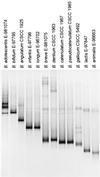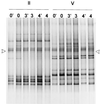Bifidobacterial diversity in human feces detected by genus-specific PCR and denaturing gradient gel electrophoresis
- PMID: 11157210
- PMCID: PMC92614
- DOI: 10.1128/AEM.67.2.504-513.2001
Bifidobacterial diversity in human feces detected by genus-specific PCR and denaturing gradient gel electrophoresis
Abstract
We describe the development and validation of a method for the qualitative analysis of complex bifidobacterial communities based on PCR and denaturing gradient gel electrophoresis (DGGE). Bifidobacterium genus-specific primers were used to amplify an approximately 520-bp fragment from the 16S ribosomal DNA (rDNA), and the fragments were separated in a sequence-specific manner in DGGE. PCR products of the same length from different bifidobacterial species showed good separation upon DGGE. DGGE of fecal 16S rDNA amplicons from five adult individuals showed host-specific populations of bifidobacteria that were stable over a period of 4 weeks. Sequencing of fecal amplicons resulted in Bifidobacterium-like sequences, confirming that the profiles indeed represent the bifidobacterial population of feces. Bifidobacterium adolescentis was found to be the most common species in feces of the human adult subjects in this study. The methodological approach revealed intragenomic 16S rDNA heterogeneity in the type strain of B. adolescentis, E-981074. The strain was found to harbor five copies of 16S rDNA, two of which were sequenced. The two 16S rDNA sequences of B. adolescentis E-981074(T) exhibited microheterogeneity differing in eight positions over almost the total length of the gene.
Figures






Similar articles
-
Polymerase chain reaction and denaturing gradient gel electrophoresis monitoring of fecal bifidobacterium populations in a prebiotic and probiotic feeding trial.Syst Appl Microbiol. 2001 Jul;24(2):227-31. doi: 10.1078/0723-2020-00035. Syst Appl Microbiol. 2001. PMID: 11518325 Clinical Trial.
-
PCR and real-time PCR primers developed for detection and identification of Bifidobacterium thermophilum in faeces.BMC Microbiol. 2008 Oct 10;8:179. doi: 10.1186/1471-2180-8-179. BMC Microbiol. 2008. PMID: 18847469 Free PMC article.
-
Temporal stability analysis of the microbiota in human feces by denaturing gradient gel electrophoresis using universal and group-specific 16S rRNA gene primers.FEMS Microbiol Ecol. 2004 Jun 1;48(3):437-46. doi: 10.1016/j.femsec.2004.03.001. FEMS Microbiol Ecol. 2004. PMID: 19712312
-
Genus- and species-specific PCR primers for the detection and identification of bifidobacteria.Curr Issues Intest Microbiol. 2003 Sep;4(2):61-9. Curr Issues Intest Microbiol. 2003. PMID: 14503690 Review.
-
DGGE/TGGE a method for identifying genes from natural ecosystems.Curr Opin Microbiol. 1999 Jun;2(3):317-22. doi: 10.1016/S1369-5274(99)80055-1. Curr Opin Microbiol. 1999. PMID: 10383868 Review.
Cited by
-
Genotypic characterization and safety assessment of lactic acid bacteria from indigenous African fermented food products.BMC Microbiol. 2012 May 17;12:75. doi: 10.1186/1471-2180-12-75. BMC Microbiol. 2012. PMID: 22594449 Free PMC article.
-
Changes in the gut microbiota of Nigerian infants within the first year of life.PLoS One. 2022 Mar 17;17(3):e0265123. doi: 10.1371/journal.pone.0265123. eCollection 2022. PLoS One. 2022. PMID: 35298505 Free PMC article.
-
Effects of dietary fat source and subtherapeutic levels of antibiotic on the bacterial community in the ileum of broiler chickens at various ages.Appl Environ Microbiol. 2002 Dec;68(12):5918-24. doi: 10.1128/AEM.68.12.5918-5924.2002. Appl Environ Microbiol. 2002. PMID: 12450811 Free PMC article.
-
A special fondness for lactobacilli.Appl Environ Microbiol. 2004 Jun;70(6):3189-94. doi: 10.1128/AEM.70.6.3189-3194.2004. Appl Environ Microbiol. 2004. PMID: 15184111 Free PMC article. Review. No abstract available.
-
Genetic diversity of viable, injured, and dead fecal bacteria assessed by fluorescence-activated cell sorting and 16S rRNA gene analysis.Appl Environ Microbiol. 2005 Aug;71(8):4679-89. doi: 10.1128/AEM.71.8.4679-4689.2005. Appl Environ Microbiol. 2005. PMID: 16085863 Free PMC article.
References
-
- Alles M S, Hartemink R, Meyboom S, Harryvan J L, Van Laere K M, Nagengast F M, Hautvast J G. Effect of transgalactooligosaccharides on the composition of the human intestinal microflora and on putative risk markers for colon cancer. Am J Clin Nutr. 1999;69:980–991. - PubMed
-
- Ballongue J. Bifidobacteria and probiotic action. In: Salminen S, von Wright A, editors. Lactic acid bacteria, microbiology and functional aspects. 2nd ed. New York, N.Y: Marcel Dekkers, Inc; 1998. pp. 519–587.
-
- Beerens H. An elective and selective isolation medium for Bifidobacterium spp. Lett Appl Microbiol. 1990;11:155–175.
Publication types
MeSH terms
Substances
Associated data
- GDB/AF275881
- Actions
- Actions
- Actions
- Actions
- Actions
- Actions
- Actions
- Actions
- Actions
- Actions
- Actions
- Actions
LinkOut - more resources
Full Text Sources
Other Literature Sources
Medical
Molecular Biology Databases

